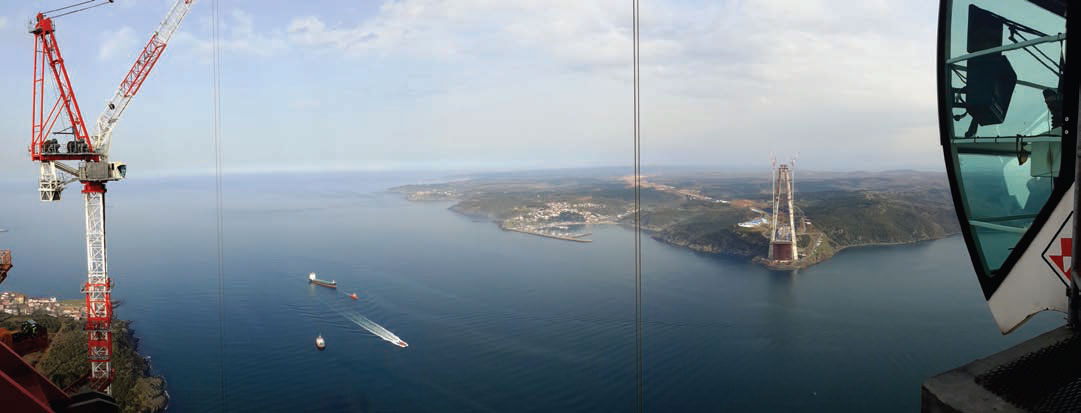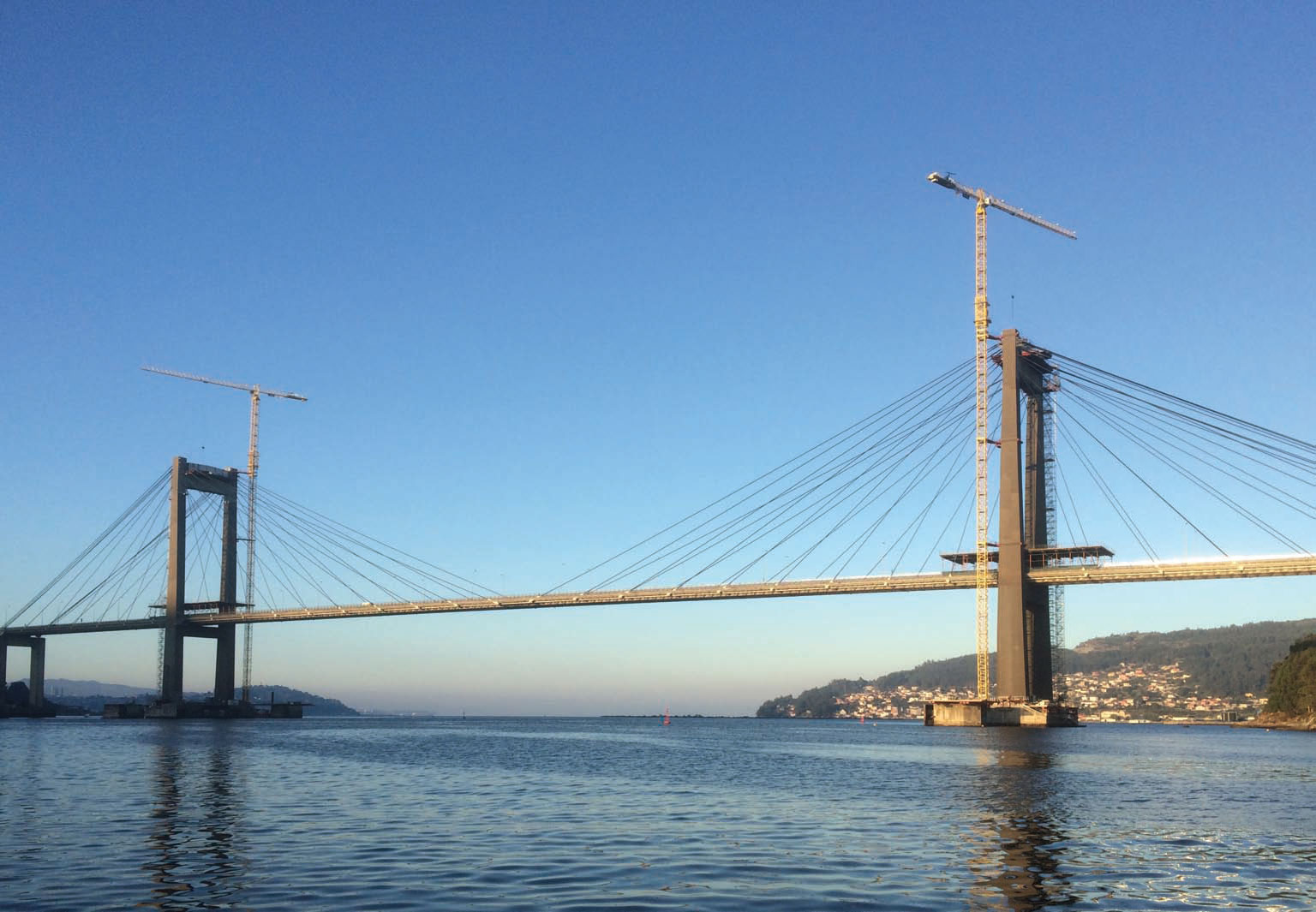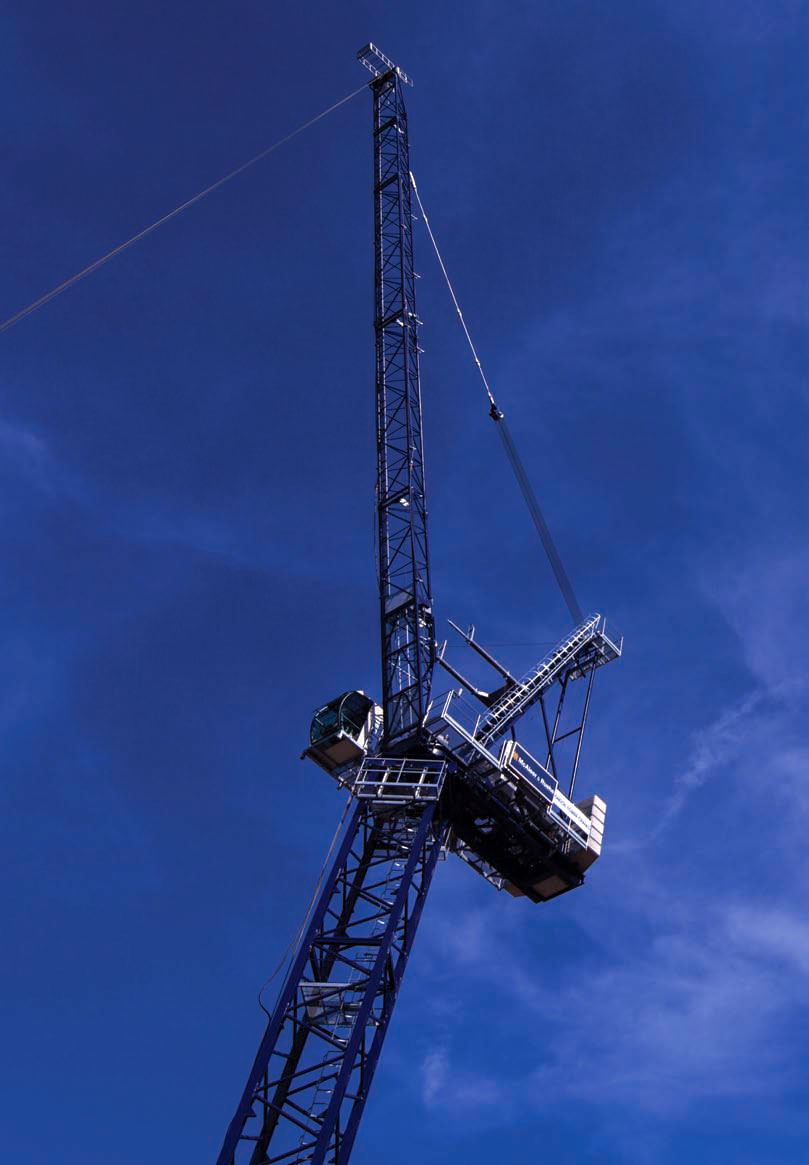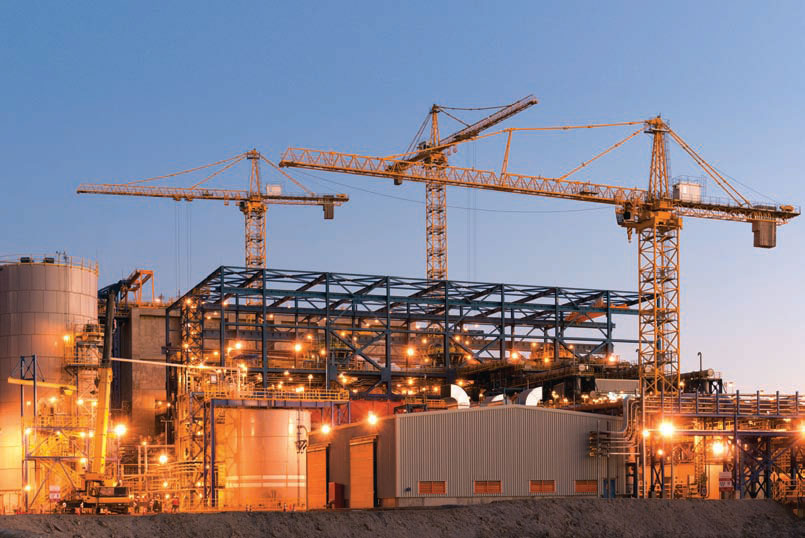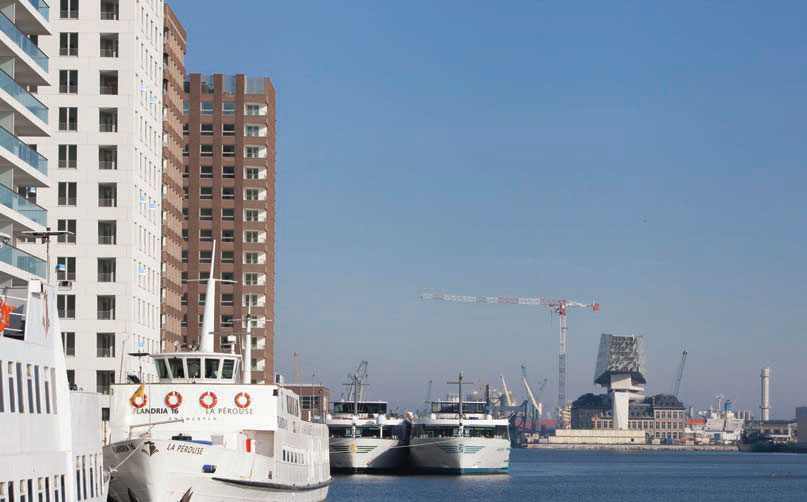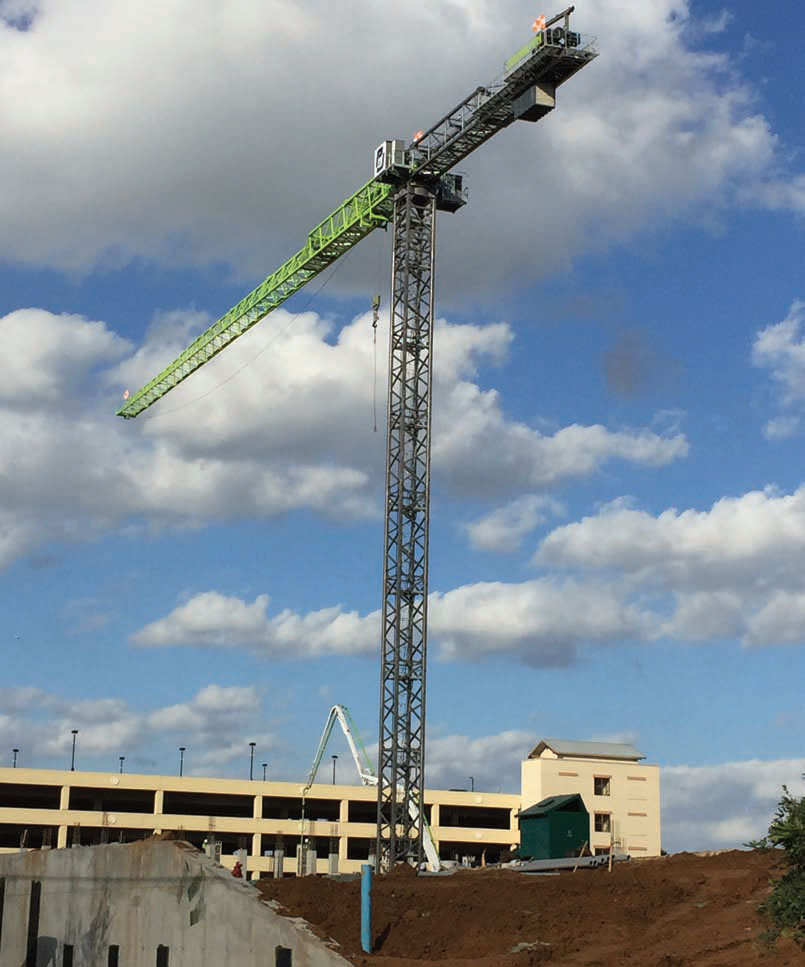High demand for high capacity tower cranes
23 January 2017The global tower crane market is shifting towards bigger equipment to satisfy the demand for lifting heavy loads and gaining productivity. Paola De Pascali reports
Increasing demand for high capacity tower cranes is pushing the main manufacturers to focus on bigger equipment. Even if the demand for small-mid size tower cranes is still good, the driving force is to use larger tower cranes to lift quickly heavy precast modules in confined spaces.
Martín Echavarría, sales manager at Linden Comansa says the LC2100 series is being very successful all over the globe, especially in US and Scandinavia.
“This family of tower cranes, with maximum load capacities of up to 48t, is one of our largest range and is a good solution for large industrial and infrastructure projects as well as for prefabricated prefinished volumetric construction (PPVC), which is getting popular,” Echavarría says. “Contractors need versatile and accurate tower cranes to lift and place any type of heavy loads in short time. Thus, we will launch in the following months our largest luffing-jib crane, the LCL700, which will hopefully help us to enter new markets.”
Juan Ballester from Saez sales department also says the biggest cranes that they sell are mainly used in infrastructure projects. “We have recently sold some cranes to the mining industry,” he adds.
Liebherr marketing and market manager Hans-Martin Frech says there is a good demand for the high-top EC-H cranes, which can handle high load capacities up to 50t. “These powerful machines are required to lift prefabricated elements in addition to lifting heavy loads for dams, power stations and mines,” Frech says.
Liebherr self-erecting cranes, Frech says, are present on many job sites for standard housing in Europe, but also for industrial buildings. “The luffing cranes are often working on internal climbing for skyscrapers,” Frech says. “The High Top cranes EC-H and the flat top cranes EC-B are powerful on big sites where a strong performance is needed. For example, the 58 EC-H tower cranes are currently working on the new Istanbul airport.”
P&J Arcomet president Stephen Jehle says the North American demand is for larger tower cranes than Europe. For example, there is a strong request for 300 and 400tm tower cranes in Canada and the US.
As exclusive distributor of Zoomlion tower cranes in North America, Jehle says, the Zoomlion T8030 is so far performing better that they anticipated. “While it is technically a 400tm crane, it is much closer to a 500tm in capacity than most people realise with 3t capacity at a full 80m jib,” Jehle adds. “Customers really appreciate this capacity because they can use our cranes in big projects. We have had some who thought they would have to rent a 500tm crane, but they were able to apply for the T8030, making the project below budget.”
Jehle also explains that the Zoomlion cranes in their fleet are not stereotypical Chinese tower cranes because they have been specifically designed for the North American market and not the domestic Chinese market. “These cranes are manufactured and assembled in China, but most of the components come from Europe,” Jehle said.
Zoomlion and P&J Arcomet began working together on the T8030-25 development in 2014. The tower crane was designed by Franc Jost, one of the leading engineers of the Peiner SK series of tower cranes. Peter Jehle developed the mechanical and electrical systems further to meet European and North American requirements.
Regarding sales, Jehle says they go up and down, but most customers in the US prefer renting than owning the equipment outright themselves. “Those that do like to own their own fleet have relied on us to service and maintain their equipment to our high standards,” Jehle says. “The biggest owners of tower cranes in the North America tend to be rental houses.”
As marketing and product manager at Arcomet, Gerd Vandecruys explains the reason why they are moving into bigger cranes. “We see that the leading tower crane manufacturers have all brought new models to the market and we notice that they are boosting the capacities of their previous models,” Vandecruys says. “There is also an increase in the use of prefabricated elements, leading to a need for bigger lifts. That means we are moving away from the very small tower cranes and focus more on bigger equipment.”
Vandecruys announced that Arcomet is currently working on a new bigger self-erector. “This crane will be the bridge between the self-erecting crane market and the tower crane market,” he says. “The launch of the machine is planned for the second half of 2017. We also have a joint venture in the US and we believe that this bigger self-erector will have its place in the US market as well.”
Best performing regions Regarding the European market, Vandecruys says, it varies between countries. For example, the German market for machines above 250tm is quite smaller than surrounding countries. “The best performers are in the 120 – 200tm class,” Vandecruys says. “Belgium and The Netherlands have a significantly bigger fleet of cranes above 300tm.
This reflects in our geographical choice for investments, of course.” Arcomet is also targeting new markets such as Poland and Scandinavia. “According to macro-economic data Sweden is currently the strongest market in Scandinavia,” Vandecruys says.
“Germany, Belgium and the UK are markets where we are already present today and so our aim is to reinforce our position.”
Terex vice president and general manager for global tower crane Marco Gentilini says their strongest markets are North America, North Europe, East Asia and Australia.
“We have sold a higher number of high capacity cranes especially with luffing jib cranes bigger than 500mt such as our Terex CTL 630B and CTL650F, but also on hammerhead and flat top models above 400m.
“The high capacity is required on several applications from highrise buildings to energy-related job sites as well as residential and commercial construction, and infrastructures,” he says. “There is also a smaller demand for cement factories or power plants”. Gentilini says the usual duties include lifting of formworks, preassembled and not pre-assembled steel structures and building equipment.
Manitowoc global product director for top slewing tower cranes Thibaut Le Besnerais explains, “Needs are different depending on geographical regions. We have a strong demand for luffing jibs such as the MR 418 and the MR 608 to reach high-rise buildings and to work in congested spaces in Southeast Asia and North America.” Conversely, luffers are less popular in Western Europe, and hammerhead cranes are the most used in this region.
“However, the general demand is to have a crane able to work in confined spaces and to complete a project in a short time,” Le Besnerais adds. “As the timeline of projects is always tight, the attitude to use heavy prefabricated elements is getting popular and so the demand for heavy-duty cranes is growing all over the world.”“This trend led us to increase the productivity of our machines on the jobsite. Our new topless CCS range has been designed to provide a safe and quick erection, easy and quick calibration and a better performance. The new CCS GME range of top slewing crane has been introduced at the end of last year and is already very successful in Europe.
“The new range is equipped with a complete new crane control system (CCS) providing better performances, better load charts and a new driving experience.” Le Besnerais adds: “Our customers appreciate that now they can set up the crane from the cab in only 15 minutes while this calibrations took three hours in the past. We can remotely access to the crane and diagnose any problems, and then we can enhance the support to our customer while we are operating the crane.
“The new CCS ensures an overall better performance for our cranes and consequently a better return on investment for our customers. This range is really well accepted in Europe and North America.”
Over the last two years there has been an increase of more than 50% in the North American tower crane market, Le Besnerais says, and the market should remain quite active in the coming years.
“Conversely, the South American market is down, specifically Brazil due to the political crisis,” he adds. “The trend is not so bad in Chile, Colombia and Peru, but we can’t compare with the state of the market in Brazil, which was buoyant in the past. For example, over the last six months only a few tower cranes were sold in Brazil while we were used to sell hundreds of tower cranes per year in the past.”
Other markets, such as the Southeast Asia and the Middle East, are showing good activity. Le Besnerais says the most popular cranes in these regions are the new Potain MCR 160 luffing jib crane and the Potain MCT 205 topless tower crane, which are designed in France and manufactured at Manitowoc’s Zhangjiagang factory in China.
“In the Middle East, Qatar and United Arab Emirates markets are going well, while Saudi Arabia is softening. In Southeast Asia, we have some quite dynamic markets such as Korea, Australia and Malaysia. Thailand was a good market until the death of the King, but since then there is uncertainty.
We see some growth opportunities in Vietnam and the Philippines. Even though the market is soft in India we expect some signs of recovery from this country.
“The driving European markets include France, Germany, Switzerland and the UK while Italy and Spain are down. The Russian market is slow due to the high volatility of the ruble and the high interest rate.
Even if construction activity remains high, rental prices are low. As rental prices increase, we may see contractors investing again.” According to Jean Pierre Zaffiro, Manitowoc’s global product director for Potain self-erecting cranes, these products are mainly targeted at the European market.
“There is a good request for the new models, the Hup 32-27 and the Hup 40-30,” he says. “Before designing and launching these products, we made market research to understand customers’ needs,” Zaffiro says. “The Hup range is replacing the Igo line, presenting standardised components to optimise owners’ fleets in addition to the new remote controls.
“We have already sold a number of Hup 32-27 units in more than 15 countries. The Hup 40-30 debuted at Niella factory in Italy for a worldwide presentation and we will start to deliver the first unit next January.”
Zaffiro adds: “In France people are buying right now more houses thanks to interesting current loans and this is creating activity for self-erecting cranes, which are required in the house-building sector.
“It’s very difficult outside Europe because we have some indirect competitors. For example in the Southeast Asia market the labour cost is so low and they use really old components and equipment rather than self-erecting cranes. Thus, we still need to show the value of self-erecting cranes and push them into the Asian market.”
Political challenges
“Being part of the construction sector, the tower crane market is mostly driven by political stability, investments in energy as well as residential, commercial and infrastructure projects,” Gentilini says.
Two political factors have mainly shaped market trends: the United States presidential elections of 2016 and Brexit in Europe.
Jehle explains, “The tower crane market is performing best in the United States and Canada with a lot of projects related to commercial and concrete construction. The residential construction is a strong market in the Southeastern coast such as Miami.
“However, presidential elections are causing uncertainty on the markets and as a result, there is a slight retention over the last few months. This is a natural contraction of the economy, but after the elections we should see a growth through next year,” Jehle says. “2017 will be strong but 2018 is quite far from us and we don’t know what will happen in the upcoming years.”
Regarding Brexit Le Besnerais explains: “We have seen that the immediate consequence is the decline of the British pound and as the main manufacturers of tower cranes are based in Europe, their equipment will be 20% more expensive than used to be. We don’t see a clear impact yet as construction activity is still high in the UK.”
Zaffiro adds Brexit will not affect so much self-erecting cranes because there is not a massive request of this kind of machines in the UK.
“Brexit could only affect the tower crane market in the UK rather than in the entire Europe,” Echavarri says. “I think that outside the UK, construction sector won’t be affected.”
It’s also impossible to predict what Brexit may bring in the coming years. “Until today all the European suppliers could not benefit from the exchange rate and now the situation has changed.”
Beyond the unclear future, Gentilini says, they have already experienced a slow down in decision making for some investments and projects.
“However, this uncertainty did not have a major impact to the overall demand for cranes. UK is definitely an important market for tower cranes and we will work with our customers to find the best solutions.”
Vandecruys: “Arcomet has just set up a joint venture with Skyline in the UK. Despite Brexit, the UK remains a strong market for us and we intend to support the new enterprise with strategic investments in the fleet.”
Being strictly related to the current state of governments, some domestic markets in South Europe are struggling to come back to their golden years.
According to Juan Ballester, sales agent for Saez, the Spanish tower crane market is recovering, but it is still far from previous sales records.
Echavarría explains that residential construction was the driver of the Spanish boom ten years ago, but it stopped drastically around 2008 and is still recovering. “Nowadays, it is growing very slowly, but only the crane rental companies can see this improvement, not the manufacturers yet,” he says. “The rental companies who managed to survive or sell part of their equipment during the crisis are renting their fleet quite well now, but with very low prices. Over the last years, there haven’t been sales of new tower cranes in Spain, and I don’t think there will be in the near future.
“The sales of new cranes would be possible in infrastructure projects where special crane models or high capacities are needed. Unfortunately, Spain is ruled by a caretaker government since December 2015 and all major projects are in stand-by mode.”
Safety
“The new tower crane regulations that are arising all over the world are making the cranes safer, and also more sophisticated, with more technology involved,” Ballester says. “We not only need to make safer cranes, but also more efficient cranes. The cranes that we will make will be quite different than cranes dated back ten years ago.”
Another factor driving change is the recent attitude to carefully plan sites before starting a project to avoid any kind of problems. “Big companies are scheduling step by step their jobs, including the structure of the building and the type of machines required for each section of construction,” Frech says. “They also decide in advance materials to be used and the place where trucks have to be parked and so on. Thus, there is a request for Building Industrial Modelling (BIM) files and other software tools to support decision-making regarding a building.”
---
Correction, 25 January 2017: An earlier version of this article included incorrectly captioned images. These have now been amended.
